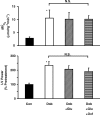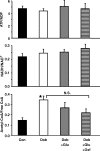Regulation of pyruvate dehydrogenase activity and citric acid cycle intermediates during high cardiac power generation
- PMID: 15550462
- PMCID: PMC1665507
- DOI: 10.1113/jphysiol.2004.075713
Regulation of pyruvate dehydrogenase activity and citric acid cycle intermediates during high cardiac power generation
Abstract
A high rate of cardiac work increases citric acid cycle (CAC) turnover and flux through pyruvate dehydrogenase (PDH); however, the mechanisms for these effects are poorly understood. We tested the hypotheses that an increase in cardiac energy expenditure: (1) activates PDH and reduces the product/substrate ratios ([NADH]/[NAD(+)] and [acetyl-CoA]/[CoA-SH]); and (2) increases the content of CAC intermediates. Measurements were made in anaesthetized pigs under control conditions and during 15 min of a high cardiac workload induced by dobutamine (Dob). A third group was made hyperglycaemic (14 mm) to stimulate flux through PDH during the high work state (Dob + Glu). Glucose and fatty acid oxidation were measured with (14)C-glucose and (3)H-oleate. Compared with control, the high workload groups had a similar increase in myocardial oxygen consumption ( and cardiac power. Dob increased PDH activity and glucose oxidation above control, but did not reduce the [NADH]/[NAD(+)] and [acetyl-CoA]/[CoA-SH] ratios, and there were no differences between the Dob and Dob + Glu groups. An additional group was treated with Dob + Glu and oxfenicine (Oxf) to inhibit fatty acid oxidation: this increased [CoA-SH] and glucose oxidation compared with Dob; however, there was no further activation of PDH or decrease in the [NADH]/[NAD(+)] ratio. Content of the 4-carbon CAC intermediates succinate, fumarate and malate increased 3-fold with Dob, but there was no change in citrate content, and the Dob + Glu and Dob + Glu + Oxf groups were not different from Dob. In conclusion, compared with normal conditions, at high myocardial energy expenditure (1) the increase in flux through PDH is regulated by activation of the enzyme complex and continues to be partially controlled through inhibition by fatty acid oxidation, and (2) there is expansion of the CAC pool size at the level of 4-carbon intermediates that is largely independent of myocardial fatty acid oxidation.
Figures






Similar articles
-
Parallel activation of mitochondrial oxidative metabolism with increased cardiac energy expenditure is not dependent on fatty acid oxidation in pigs.J Physiol. 2007 Mar 15;579(Pt 3):811-21. doi: 10.1113/jphysiol.2006.123828. Epub 2006 Dec 21. J Physiol. 2007. PMID: 17185335 Free PMC article.
-
Metabolic response to an acute jump in cardiac workload: effects on malonyl-CoA, mechanical efficiency, and fatty acid oxidation.Am J Physiol Heart Circ Physiol. 2008 Feb;294(2):H954-60. doi: 10.1152/ajpheart.00557.2007. Epub 2007 Dec 14. Am J Physiol Heart Circ Physiol. 2008. PMID: 18083904
-
Mechanism of pyruvate dehydrogenase activation by increased cardiac work.J Mol Cell Cardiol. 1983 Jun;15(6):369-82. doi: 10.1016/0022-2828(83)90321-8. J Mol Cell Cardiol. 1983. PMID: 6876186
-
Regulation by carnitine of myocardial fatty acid and carbohydrate metabolism under normal and pathological conditions.Basic Res Cardiol. 2000 Apr;95(2):75-83. doi: 10.1007/s003950050167. Basic Res Cardiol. 2000. PMID: 10826498 Review.
-
Fatty acid oxidation in the heart.J Cardiovasc Pharmacol. 1996;28 Suppl 1:S11-7. doi: 10.1097/00005344-199600003-00003. J Cardiovasc Pharmacol. 1996. PMID: 8891866 Review.
Cited by
-
Faster and stronger manifestation of mitochondrial diseases in skeletal muscle than in heart related to cytosolic inorganic phosphate (Pi) accumulation.J Appl Physiol (1985). 2016 Aug 1;121(2):424-37. doi: 10.1152/japplphysiol.00358.2016. Epub 2016 Jun 9. J Appl Physiol (1985). 2016. PMID: 27283913 Free PMC article.
-
In vivo investigation of cardiac metabolism in the rat using MRS of hyperpolarized [1-13C] and [2-13C]pyruvate.NMR Biomed. 2013 Dec;26(12):1680-7. doi: 10.1002/nbm.3003. Epub 2013 Jul 31. NMR Biomed. 2013. PMID: 23904148 Free PMC article.
-
Myocardial reloading after extracorporeal membrane oxygenation alters substrate metabolism while promoting protein synthesis.J Am Heart Assoc. 2013 Aug 19;2(4):e000106. doi: 10.1161/JAHA.113.000106. J Am Heart Assoc. 2013. PMID: 23959443 Free PMC article.
-
Effect of prednisolone on glyoxalase 1 in an inbred mouse model of aristolochic acid nephropathy using a proteomics method with fluorogenic derivatization-liquid chromatography-tandem mass spectrometry.PLoS One. 2020 Jan 22;15(1):e0227838. doi: 10.1371/journal.pone.0227838. eCollection 2020. PLoS One. 2020. PMID: 31968011 Free PMC article.
-
Mitochondrial metabolism and the control of vascular smooth muscle cell proliferation.Front Cell Dev Biol. 2014 Dec 15;2:72. doi: 10.3389/fcell.2014.00072. eCollection 2014. Front Cell Dev Biol. 2014. PMID: 25566542 Free PMC article. Review.
References
-
- Aragon JJ, Lowenstein JM. The purine-nucleotide cycle. Comparison of the levels of citric acid cycle intermediates with the operation of the purine nucleotide cycle in rat skeletal muscle during exercise and recovery from exercise. Eur J Biochem. 1980;110:371–377. - PubMed
-
- Ashruf JF, Coremans JM, Bruining HA, Ince C. Increase of cardiac work is associated with decrease of mitochondrial NADH. Am J Physiol. 1995;269:H856–862. - PubMed
-
- Balaban RS, Kantor HL, Katz LA, Briggs RW. Relation between work and phosphate metabolite in the in vivo paced mammalian heart. Science. 1986;232:1121–1123. - PubMed
-
- Bergmeyer HU. Method of Enzymatic Analysis: Metabolites 2. 3. Weinhein: VCH-Verlagsgesellschaft; 1989.
-
- Bruce M, Constantin-Teodosiu D, Greenhaff PL, Boobis LH, Williams C, Bowtell JL. Glutamine supplementation promotes anaplerosis but not oxidative energy delivery in human skeletal muscle. Am J Physiol Endocrinol Metab. 2001;280:E669–675. - PubMed
Publication types
MeSH terms
Substances
Grants and funding
LinkOut - more resources
Full Text Sources
Other Literature Sources

